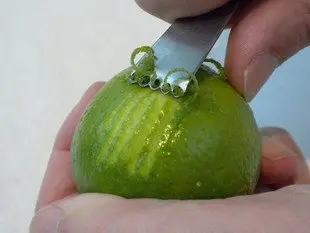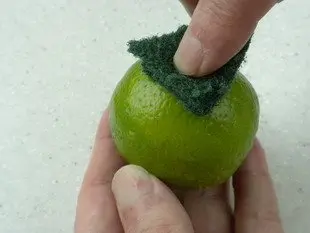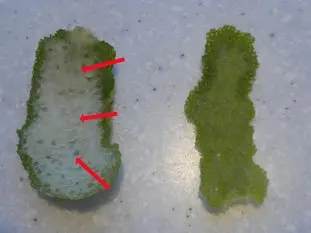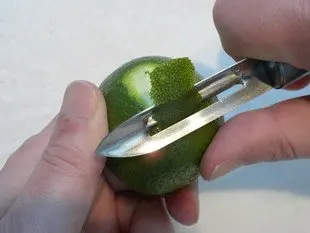This site uses only a few technical cookies necessary for its operation. By continuing to browse, you accept their use.
To find out more...
To find out more...
How to zest a fruit?

You will have no doubt noticed that many recipes call for the zest of citrus fruit. The zest is that outer layer of the skin which adds so much flavour to a dish.
There are many different ways to peel off the zest and various tools are available. Here is a summary of the “dos and don'ts” of zesting.
There are many different ways to peel off the zest and various tools are available. Here is a summary of the “dos and don'ts” of zesting.
47 K 3.8/5 (59 reviews)
Keywords for this post:ZestZisteZesterGraterFruitCitrusSkinPeelLast modified on: November 5th 2013
How to zest a fruit?
Good fruits
First and foremost: zesting a fruit means removing the upper, outer part of the rind, which also happens to be the part that receives most of the chemical treatment inflicted on the fruit.

So be careful: you absolutely must wash the fruit thoroughly before zesting it, but the best thing to do is to use organic fruit, which is guaranteed to be untreated.
The right part of the fruit
The part of the peel that can be zested is generally very thin, 1 millimetre or less, so it's very important to remove only the coloured part of the peel - the zest - and not the white part underneath, which is not zest but a major source of bitterness, to be avoided at all costs!

In this photo, you can see the zest on the right and the white part of the peel on the left.
The right tools
There are a number of more or less effective tools for zesting:


1) The peeler or a sharp knife: with it, you delicately "peel" the fruit and obtain small strips of zest (colored, remember: no white) which you then have to cut into strips, then into tiny pieces. It's not very fast, nor very efficient, but it works.


2) The zester: this is a strangely-shaped knife that zests by making tiny filaments. The structure of the zester means that you can't remove any white parts, which is interesting. The only drawback is that the zest obtained is a little "crushed" and "exuded", so it's not great.


3) The zester grater: This is a bit like a cheese grater, very fine, on which you rub the fruit while rotating it (be careful, it's the fruit that moves, not the grater).
It's by far the most efficient of all tools, and you can find out more about it on this page.
Lasts posts
Butter vs. grease
We often read in a recipe where a pastry is put into a mould that, just before pouring, the mould should be buttered or greased. But what's the difference between these 2 terms?December 1st 20251,4295
Getting out of the fridge early
Very often when you're cooking, you need to take food or preparations out of the fridge, to use them in the recipe in progress. There's nothing tricky about this: you just take them out of the fridge and use them, usually immediately, in the recipe. But is this really a good method?November 24th 20251,2745
Who's making the croissants?
When you look at a bakery from the outside, you naturally think that in the bakery, the bakers make the bread, and in the laboratory, the pastry chefs make the cakes. It's very often like that, with each of these professions having quite different ways of working, but sometimes there's also one...November 23th 20251,165
Oven height
When we put a dish or cake in the oven, we naturally tend to put it on the middle shelf, and that's what we usually do. But in some cases, this position and height can be a little tricky, so let's find out why.October 8th 20253,2755
The importance of sieving
In recipes that use a fine powder (flour, powdered sugar, etc.), you'll often see the advice to sift before using it. To sift is to pass the powder in question through a sieve (a very fine strainer) before incorporating it into your recipe. It's often advice, but is it really useful?September 3rd 20257,9013
Other pages you may also like
The 3 kinds of meringue
Meringue – what could be simpler? Just beaten egg whites with sugar added. This makes a fairly stiff mixture which can then be cooked in a cool oven to create those lovely, light confections. But in the world of professional patisserie, meringue comes in three different kinds. Even if the...June 14th 201365 K4.5
The window-pane test in bread-making
The home bread-makers often ask themselves “Have I kneaded my dough long enough?” . A good question, as dough that is insufficiently kneaded will not rise properly or will fall flat when the top is slashed, which is very frustrating. To know when the dough is ready, one can rely on the length...June 16th 202197 K 23.9
Tranché, dissociated, failed, in short... missed!
When preparing a sauce or a cream, there's always a (small) risk that the creamy preparation you're working on will suddenly separate into two parts of different textures: a liquid part, for example, and a more or less solid part, or even become lumpy. It's terribly frustrating, but we'll see...June 19th 202313 K5
A few tips for effective kneading at home
When you have to knead dough for bread or some other recipe, you may well use a food processor or the type of machine known as a stand mixer. The best-known brands are Kenwood and KitchenAid. They are useful tools, but here are a few tips to help you get the best out of them.June 23th 2021284 K 23.8
Kitchen ovens
You certainly have one in your kitchen, an oven, the essential tool for all kinds of cooking, whether in the kitchen of course, but also in pastry, bakery, pizza, and many others. Here is some information on its structure and operation.May 16th 202034 K4.4
Post a comment or question
Follow this page
If you are interested in this page, you can "follow" it, by entering your email address here. You will then receive a notification immediately each time the page is modified or a new comment is added. Please note that you will need to confirm this following.
Note: We'll never share your e-mail address with anyone else.
Alternatively: you can subscribe to the mailing list of cooling-ez.com , you will receive a e-mail for each new recipe published on the site.









